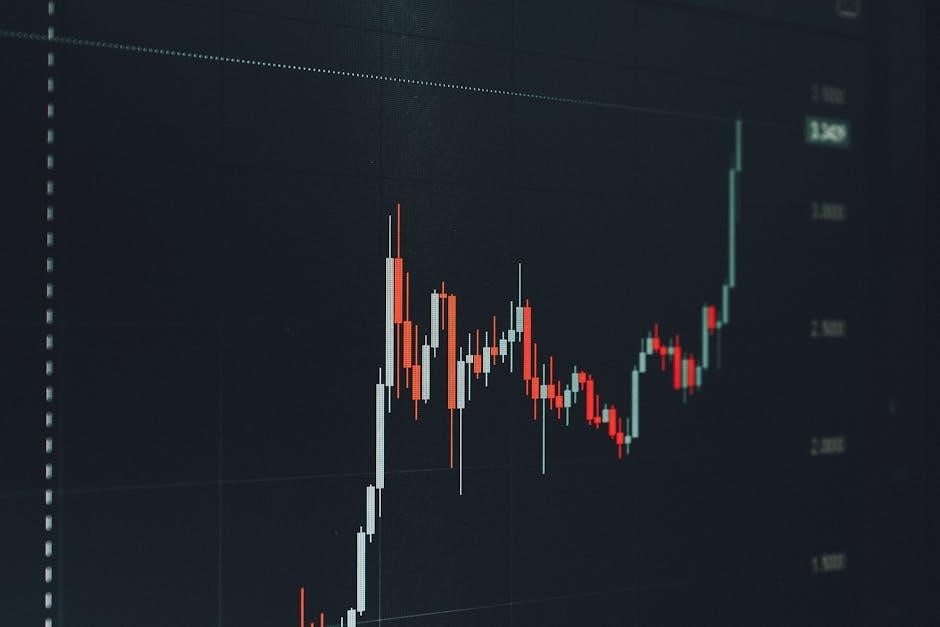Bullish candlestick patterns are visual indicators that signal potential upward price movements, helping traders identify trends and make informed decisions. These patterns are widely used in various markets.
Definition and Importance
Bullish candlestick patterns are visual tools that represent price fluctuations over a specific period, signaling potential upward movements in the market. These patterns are formed by analyzing the opening and closing prices, as well as the highs and lows of trading sessions. They are essential for traders as they provide insights into market sentiment and potential trend reversals or continuations. By identifying these patterns, traders can make informed decisions to enter or exit trades. Bullish patterns are particularly valuable in trending markets, where they often indicate strong buying momentum. Their importance lies in their ability to help traders anticipate price movements and align their strategies with market dynamics.
Historical Background
Candlestick charting traces its origins to 17th-century Japan, where rice traders used similar techniques to track price fluctuations. The method was later popularized in the West by Steve Nison, who introduced candlestick patterns to modern traders. Bullish patterns, in particular, have historical roots in identifying market reversals and trend continuations. They evolved from observing repeated price behaviors and their outcomes. Over time, traders refined these patterns, incorporating them into technical analysis. Today, they remain a cornerstone of price action strategies, offering timeless insights into market psychology and investor behavior. Their historical development underscores their enduring relevance in financial markets.
Key Characteristics of Bullish Patterns
Bullish candlestick patterns are defined by their ability to signal potential upward price movements. These patterns often form at the end of a downtrend or during periods of consolidation, indicating a shift in market sentiment. They are characterized by specific formations, such as long bullish candles, hammer shapes, or engulfing structures, which reflect buying pressure. A key feature is the closing price being higher than the opening price, signaling buyer dominance. Shadows and wicks provide additional context, with long lower shadows often indicating rejection of lower prices. These patterns are reliable when confirmed by volume and align with broader market trends, making them valuable tools for traders seeking entry points in rising markets.

Single Candlestick Patterns
Single candlestick patterns are formations created by one candle, signaling potential reversals or trend continuations. They help identify shifts in buyer or seller control, guiding traders.
Hammer Pattern
The Hammer pattern is a bullish reversal candlestick formation that appears after a downtrend. It consists of a small candle body and a long lower shadow, indicating that buyers are gaining control. The hammer’s long shadow suggests that prices were pushed lower but rebounded, showing strong buying interest. This pattern signals a potential reversal, as the market rejects lower prices and starts to rise. Traders often use the hammer as a sign to enter long positions, anticipating an upward movement. It is most effective when confirmed by subsequent price action or other indicators, making it a valuable tool in identifying trend reversals.
Inverted Hammer Pattern
The Inverted Hammer is a bullish reversal candlestick pattern, often signaling a potential uptrend after a decline. It features a small body and a long upper shadow, indicating that buyers are challenging sellers. The long wick shows rejection of lower prices, suggesting strength. This pattern is more reliable when confirmed by rising volumes or support levels. Traders use it to anticipate trend reversals, especially in oversold conditions. While it can signal a bullish reversal, it’s important to confirm with subsequent price action to avoid false signals, ensuring a more accurate trading strategy and decision-making process in financial markets.
Dragonfly Doji Pattern
The Dragonfly Doji is a bullish candlestick pattern characterized by a small or nonexistent body and a long lower shadow. It forms when the opening and closing prices are nearly identical, creating a “T” shape. This pattern suggests market indecision but can signal a potential bullish reversal, especially when appearing after a downtrend. The long lower shadow indicates that sellers pushed prices down, but buyers regained control, driving prices back up. While it reflects uncertainty, the Dragonfly Doji can indicate a shift in momentum, signaling that buyers may be preparing to take control of the market. It is often seen as a sign of support and potential upward movement in the price action.
Bullish Spinning Top Pattern
The Bullish Spinning Top is a candlestick pattern that indicates market indecision but leans slightly bullish. It has a small body with long upper and lower shadows. This pattern suggests that both buyers and sellers are active, but neither has clear control. The long shadows indicate significant price fluctuations during the session. While the Spinning Top can appear in both uptrends and downtrends, the bullish interpretation often comes when it appears after a decline, signaling a potential pause or reversal. Traders may view it as a sign of weakening selling pressure, hinting at a possible bullish trend continuation or consolidation. However, confirmation from subsequent price action is typically needed to validate this outlook. The pattern’s significance increases when combined with other indicators or support levels. It serves as a cautionary signal, reminding traders to stay vigilant for further developments. The Bullish Spinning Top is versatile, applicable across various time frames and markets, making it a valuable tool for identifying potential shifts in market sentiment.
Bullish Marubozu Pattern
The Bullish Marubozu is a powerful candlestick pattern signaling strong buyer dominance. It appears as a long, green (or white) candle with no upper or lower shadows, indicating the opening price was the low and the closing price the high. This pattern reflects uninterrupted buying pressure throughout the session, with no significant selling opposition. Often seen as a sign of a new uptrend or continuation of an existing bullish trend, the Bullish Marubozu is particularly potent when occurring at key support levels or after a period of consolidation. Traders often interpret it as a buy signal, anticipating further price increases. Its absence of wicks underscores the strength of the bullish momentum, making it a reliable indicator for entering long positions. The pattern is widely recognized across various markets, including stocks, commodities, and cryptocurrencies, enhancing its versatility and reliability in trading strategies.
Double Candlestick Patterns
Double candlestick patterns involve two consecutive candles, revealing shifts in market sentiment. They often signal trend reversals or continuations, helping traders identify potential opportunities or risks. These patterns are widely used in various markets.
Bullish Engulfing Pattern
The Bullish Engulfing Pattern is a powerful two-candlestick formation signaling a potential trend reversal. It occurs when a small bearish candle is followed by a larger bullish candle that “engulfs” the previous candle. This pattern indicates strong buying pressure, as bulls overpower bears, often leading to upward price movement. It is commonly observed at the end of a downtrend or during periods of consolidation. Traders use this pattern to identify entry points for long positions, as it suggests a shift in market sentiment from bearish to bullish. The engulfing candle’s size and color emphasize the strength of the bullish momentum, making it a reliable signal in various trading strategies. This pattern is widely recognized and utilized across different financial markets.
Piercing Line Pattern
The Piercing Line Pattern is a bullish reversal signal that appears after a downtrend. It consists of two candles: the first is a long red candle, followed by a green candle that opens below the first candle’s low but closes above its midpoint. This pattern indicates that selling pressure is weakening, and buyers are gaining control. The piercing line suggests a potential trend reversal or continuation, often leading to upward price movement. Traders consider it a strong signal when confirmed with other indicators, such as rising moving averages or increasing volume. It is commonly used in forex and stock trading to identify entry points for long positions.
Bullish Harami Pattern
The Bullish Harami Pattern is a two-candlestick formation that signals a potential bullish reversal. It occurs after a downtrend and consists of a large red candle followed by a smaller green candle that fits entirely within the body of the first candle. This pattern reflects a shift in market sentiment, as buyers begin to regain control. The smaller candle represents a “pregnant” state, indicating a possible end to the downward trend. Traders often use this pattern as a sign to enter long positions, especially when confirmed by other indicators like moving averages or RSI. It is a reliable signal in trending markets but less effective in sideways or volatile conditions.
Bullish Harami Cross Pattern
The Bullish Harami Cross Pattern is a two-candlestick formation that signals a potential bullish reversal. It occurs when a small Doji candle appears after a large bearish candle, with the Doji entirely within the body of the first candle. This pattern indicates indecision in the market, as the Doji suggests a balance between buyers and sellers. After a downtrend, the Harami Cross can signal a shift in momentum, with buyers gaining control. It is often seen as a strong reversal signal, especially when confirmed by other indicators like support levels or moving averages. Traders may use this pattern to enter long positions, anticipating an upward move.

Triple Candlestick Patterns
Triple candlestick patterns involve three consecutive candles, offering strong signals about market trends. They often indicate reversals or continuations, helping traders anticipate price movements more accurately.
Three White Soldiers Pattern
The Three White Soldiers pattern is a bullish reversal signal consisting of three consecutive white (or green) candles with higher opening and closing prices each day. This formation typically appears after a downtrend, signaling a shift in momentum where buyers regain control. Each candle’s body is larger than the previous, indicating increasing confidence in the upward direction. Traders often use this pattern to enter long positions, expecting further price appreciation. It’s particularly strong when confirmed by rising trading volumes, reinforcing the bullish sentiment. This pattern is widely recognized for its reliability in signaling the start of an uptrend.
Morning Star Pattern
Morning Star Pattern
The Morning Star is a bullish reversal pattern that signals the end of a downtrend and the potential start of an uptrend. It consists of three candles: a large bearish candle, followed by a small-bodied candle (often a Doji), and then a large bullish candle. The middle candle represents indecision, while the third candle confirms the reversal. For a valid signal, the bullish candle should close above the midpoint of the first bearish candle. This pattern is stronger when the third candle is accompanied by increased trading volume, indicating a shift in market sentiment. It’s a reliable indicator for traders looking to enter long positions;
Bullish Tri Star Pattern
The Bullish Tri Star is a rare and powerful triple candlestick formation that signals a strong bullish reversal. It consists of three candles: a bearish candle, followed by a Star (a candle with a gap above the first), and then another Star that gaps above the second. The middle candle is typically a Doji, indicating indecision, while the third candle confirms the reversal. This pattern is highly reliable when it appears after a downtrend, as it reflects a shift in momentum. Traders often look for volume confirmation on the third candle to strengthen the signal. The Bullish Tri Star is a clear indication of a potential uptrend, making it a valuable tool for identifying reversal opportunities.

Confirmation Patterns
Confirmation patterns reinforce bullish signals, ensuring traders validate trends before acting. They combine indicators like moving averages or volumes with candlestick signals to confirm reversal or continuation strength.
Bullish Kickoff Pattern
The Bullish Kickoff Pattern is a powerful confirmation signal that occurs after a period of consolidation or a downtrend, signaling a strong potential for an upward price reversal. It typically forms when a bullish candlestick pattern, such as a hammer or engulfing pattern, appears at a key support level or after a significant retracement. This pattern reinforces the idea that buying pressure is gaining momentum, often leading to a breakout or continuation of the uptrend. Traders use this pattern to confirm the strength of a bullish signal, combining it with indicators like moving averages or volume analysis to increase the reliability of their trades. It is particularly effective in trending markets, where clear reversals are more likely to follow such formations.
Bullish Saucer Pattern
The Bullish Saucer Pattern is a continuation or reversal signal characterized by a series of consecutive green candles with progressively higher lows, resembling the shape of a saucer. This pattern indicates a steady accumulation phase where buyers gradually gain control, often leading to a breakout or further upward movement. It is commonly observed in uptrending markets and is used by traders to confirm the strength of the bullish momentum. The pattern’s formation suggests that the market is “bottoming out” and preparing for a sustained rally, making it a valuable tool for identifying potential buying opportunities in both scalping and swing trading strategies.
How to Trade Using Bullish Candlestick Patterns
Traders can enhance their strategies by combining bullish candlestick patterns with indicators like moving averages and identifying key support/resistance levels to execute precise trades.
Combining with Moving Averages
Combining bullish candlestick patterns with moving averages (MAs) enhances trading accuracy. A 50-period MA can identify the primary trend, while a 21-period MA highlights short-term momentum. When a bullish pattern forms above the 50-period MA, it confirms an uptrend. For example, a Hammer or Bullish Engulfing pattern aligning with a price bounce off the MA signals a strong buy opportunity. Additionally, the crossover of shorter and longer MAs can reinforce bullish signals. This dual approach helps traders filter out false signals and execute trades with higher confidence, maximizing the reliability of bullish candlestick patterns in various market conditions.
Identifying Support and Resistance Levels
Identifying support and resistance levels is crucial when trading with bullish candlestick patterns. Support levels act as price floors, while resistance levels are ceilings that hinder upward movement. Bullish patterns like the Hammer or Bullish Engulfing often form at support levels, signaling potential reversals. Integrating these levels with pattern analysis helps traders identify high-probability entry points. For instance, a Hammer pattern at a strong support level suggests a rally. Similarly, a Bullish Engulfing pattern breaking above resistance confirms upward momentum. Using tools like trendlines or previous highs/lows to mark these levels enhances trading decisions, allowing for precise executions and maximizing profitability in various market conditions effectively.
Using Indicators for Confirmation
Combining bullish candlestick patterns with technical indicators enhances trading accuracy. Indicators like Moving Averages, RSI, and MACD help confirm the strength of a potential uptrend. For example, a Hammer pattern paired with a bullish RSI divergence strengthens the case for a reversal. Similarly, a Bullish Engulfing pattern confirmed by a rising MACD line indicates strong buying momentum. Bollinger Bands can also highlight volatility, with price breaks above the upper band signaling a robust bullish signal. Using indicators ensures traders avoid false signals and enter trades with higher confidence, aligning pattern analysis with broader market dynamics for improved decision-making and risk management in various trading strategies effectively.
Psychology Behind Bullish Patterns
Bullish patterns reveal buyer dominance and shifting market sentiment, indicating a potential transition from selling to buying pressure, signaling optimism and upward price movement likelihood in the market.
Buyer Dominance
Bullish candlestick patterns often reflect buyer dominance, where upward price movements indicate strong buying pressure. This occurs when the closing price is higher than the opening, signaling control by buyers. Such patterns, like the Hammer or Bullish Engulfing, show rejection of lower prices, highlighting a shift in power. The presence of long green candles or engulfing patterns emphasizes buying strength, suggesting potential trend reversals or continuations. Traders use these signals to identify entry points, as sustained buying pressure can lead to further price increases, reinforcing the importance of recognizing these indicators in market analysis and trading strategies.
Market Sentiment Shifts
Bullish candlestick patterns are powerful indicators of market sentiment shifts, revealing transitions from bearish to bullish trends. These patterns, such as the Hammer or Piercing Line, often signal a reversal in investor confidence, where buyers regain control. The emergence of such patterns after a downtrend indicates diminishing selling pressure and the onset of optimism. Traders rely on these signals to anticipate potential price rallies, as they reflect a collective change in market perception. By identifying these shifts, traders can align their strategies with emerging trends, leveraging the psychological dynamics driving price movements in various financial markets.

Common Mistakes to Avoid
Ignoring market context and overtrading are common pitfalls. Traders must avoid relying solely on patterns without confirming with other indicators or support/resistance levels for accuracy.
Ignoring Market Context
Ignoring market context is a significant mistake when using bullish candlestick patterns; Traders often overlook the broader market trend, leading to false signals. For instance, a hammer pattern in a strong downtrend may not signal a reversal but merely a pause. It’s crucial to analyze the overall market direction, support/resistance levels, and volume to confirm the pattern’s reliability. Without context, even the most bullish patterns can fail, resulting in losses. Always combine pattern recognition with other indicators and trend analysis for accurate trading decisions.
Overtrading with Patterns
Overtrading with bullish candlestick patterns is a common mistake that can lead to significant losses. Traders often enter multiple positions based on frequent pattern appearances, ignoring market conditions. This approach increases transaction costs and exposure to market volatility. Relying solely on patterns without confirming with other indicators can result in overleverage and poor risk management. It’s essential to balance pattern recognition with fundamental analysis and strict trading plans to avoid impulsive decisions. Overtrading dilutes potential gains and heightens emotional stress, making it crucial to prioritize quality over quantity in trade setups. Discipline and patience are key to avoiding this pitfall.

Practical Applications
Bullish candlestick patterns are versatile tools for scalping, swing trading, and long-term investing, helping traders identify entry points and potential price reversals in various market conditions effectively.
Scalping Strategies
Scalping strategies leverage bullish candlestick patterns to capitalize on short-term price movements; Traders use patterns like the Hammer or Bullish Engulfing to identify quick entry and exit points. These setups often emerge during high liquidity, allowing for rapid executions. By focusing on lower timeframes (e.g., 5-minute or 15-minute charts), scalpers aim to profit from small price fluctuations. Combining these patterns with indicators like moving averages or RSI can enhance accuracy. Risk management tools, such as tight stop-loss orders, are crucial to limit losses. Scalping requires discipline and quick decision-making, making it ideal for traders who thrive in fast-paced environments. Bullish patterns help scalpers identify potential breakout points efficiently.
Swing Trading Setups
Swing trading setups utilize bullish candlestick patterns to capture medium-term trends. Patterns like the Morning Star or Three White Soldiers signal potential reversals or continuations. Traders often combine these patterns with support/resistance levels and moving averages to confirm entries. For example, a Bullish Engulfing pattern near a support level can indicate a strong buy signal. Swing traders hold positions for days to weeks, aiming to ride the trend. Risk management is key, with stop-loss orders placed below the pattern’s low. These setups are ideal for those who want to capitalize on market momentum without the intensity of day trading. Bullish patterns help swing traders identify high-probability setups for consistent profits.
Long-Term Investing
Long-term investing with bullish candlestick patterns focuses on identifying strong trends and market shifts. Patterns like the Three White Soldiers and Bullish Marubozu indicate sustained buying pressure, signaling potential long-term growth. Investors use these patterns to spot emerging trends, often holding positions for months or years. By combining these signals with fundamental analysis, investors can build robust portfolios. Bullish patterns help identify entry points with high conviction, reducing uncertainty in long-term strategies. This approach aligns with patient investors seeking to capitalize on market structure and minimize short-term noise, ensuring steady returns over time.
Resources for Learning
Online courses and tutorials provide structured learning paths for mastering bullish candlestick patterns. Platforms like Udemy and Coursera offer detailed courses, while YouTube channels share practical insights.
Candlestick Pattern Cheat Sheets
A candlestick pattern cheat sheet is an essential tool for traders, offering a quick reference guide to identify and interpret bullish and bearish patterns. These sheets typically include detailed illustrations of each pattern, explanations of their meanings, and insights into potential price movements. Many cheat sheets are available in PDF format, making them easy to download and use while analyzing charts. They cover single, double, and triple candlestick patterns, providing clear visuals and concise descriptions. By using a cheat sheet, traders can rapidly recognize patterns like the hammer, engulfing, or piercing line, helping them make timely and informed trading decisions. This resource is invaluable for both new and experienced traders aiming to enhance their technical analysis skills and improve trading outcomes.
PDF Guides and eBooks
PDF guides and eBooks are comprehensive resources for mastering bullish candlestick patterns. These materials provide detailed explanations, visuals, and real-world examples to help traders understand and apply these patterns effectively. Many guides are available for free or purchase, offering in-depth insights into market psychology, trend identification, and strategy development. They often include step-by-step instructions for recognizing patterns like the hammer, engulfing, and piercing line. Additionally, these resources frequently cover how to combine patterns with other technical indicators for higher accuracy. Whether you’re a novice or an experienced trader, PDF guides and eBooks are invaluable tools for refining your skills and improving trading outcomes in any market.
Online Courses and Tutorials
Online courses and tutorials provide interactive and structured learning for mastering bullish candlestick patterns. Platforms like Udemy, Coursera, and specialized trading websites offer courses tailored for both beginners and advanced traders. These courses often include video lessons, quizzes, and real-world examples to enhance understanding. Many tutorials focus on practical applications, such as combining patterns with indicators or identifying market sentiment shifts. Some courses also offer live trading sessions or assignments to apply knowledge in real-time. Additionally, these resources frequently include access to downloadable materials, such as PDF guides, to reinforce learning. Online courses are an excellent way to gain hands-on experience and improve trading skills systematically.
Mastering bullish candlestick patterns enhances trading strategies. Utilize PDF guides and online resources to deepen your knowledge and improve market analysis skills effectively.
Final Thoughts
Bullish candlestick patterns are invaluable tools for traders, offering insights into potential market reversals and continuations. By mastering these patterns, traders can make informed decisions, enhancing their strategies. These visual representations of price movements provide clear signals, such as the Hammer or Bullish Engulfing patterns, which indicate upward trends. Utilizing resources like PDF guides and cheat sheets can deepen understanding and improve analysis. Remember, while these patterns are powerful, they work best when combined with other indicators and contextual market analysis. Continuous learning and practice are key to harnessing their full potential in trading successfully.
Next Steps for Traders
After mastering bullish candlestick patterns, traders should practice identifying them on real-time charts and backtest strategies to validate their effectiveness. Combining these patterns with other indicators, such as moving averages or RSI, can enhance trading decisions. Traders are encouraged to download a bullish candlestick patterns PDF cheat sheet for quick reference. Starting with a demo account to refine skills is recommended before applying strategies in live markets. Continuous learning through online courses and staying updated with market trends will further improve trading outcomes. By integrating these patterns into a comprehensive strategy, traders can achieve greater consistency and success in their trading journeys.
